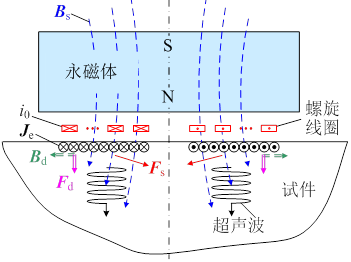Introduction to Electromagnetic Ultrasonic Technology
Release time:
2017-02-10
As a relatively ideal alternative to traditional piezoelectric ultrasonic technology, countries such as the United States, Germany, the United Kingdom, and Japan place great importance on electromagnetic ultrasonic non-destructive testing technology, with significant investments in both funding support and personnel allocation. In recent years, these countries have conducted extensive and in-depth research on this technology and have successfully applied it in various fields such as metallurgy, welding, train wheel tracks, pipelines, bridges, aircraft, plates, and bars, with some of these products already entering the Chinese market. However, research on electromagnetic ultrasonic non-destructive testing in China started relatively late, and there are currently fewer reports on electromagnetic ultrasonic non-destructive testing products.
Measuring the advancement of a country's basic industries, non-destructive testing is one of the important factors. Former U.S. President Reagan once said that without advanced non-destructive testing technology, the United States could not enjoy its leading position in many fields! This shows the important role of non-destructive testing in the national economy.
The purpose of non-destructive testing is to quantitatively understand the relationship between defects and strength, evaluate the allowable load, lifespan, or remaining lifespan of components; and to assess the structural integrity and defects arising from manufacturing or usage. This is to improve manufacturing processes, enhance product quality, timely detect faults, and ensure that equipment operates safely, efficiently, and reliably. Non-destructive testing technology is widely applied in various industries such as machinery manufacturing, petrochemicals, shipbuilding, automotive, railways, construction, metallurgy, aerospace, and nuclear energy, creating considerable economic and social benefits.
Ultrasonic non-destructive testing technology is one of the five major conventional testing technologies, characterized by high detection accuracy, wide range, precise defect location, and convenient on-site operation. It is the most widely used non-destructive testing technology, reflected in improving product quality, product design, processing and manufacturing, finished product inspection, and various stages of equipment service. Ultrasonic non-destructive testing is significant for enhancing product quality and core competitiveness.
Existing ultrasonic non-destructive testing methods typically use piezoelectric ultrasonic detection methods, but they face issues such as reliance on acoustic couplants and limitations in detection scenarios, making them difficult to use in high-temperature, low-temperature, and online detection fields.
Electromagnetic ultrasonic non-destructive testing technology is a new type of ultrasonic non-destructive testing technology centered around electromagnetic acoustic transducers (EMAT). Compared to traditional piezoelectric ultrasonic technology, this technology has advantages such as no need for couplants during detection, no contact with the test piece, and no need for surface pretreatment of the test piece, allowing for the convenient generation of various types of ultrasonic waves, making it suitable for non-contact detection, high-temperature detection, and high-speed online detection. Electromagnetic ultrasonic technology significantly improves the detection accuracy, efficiency, application range, environmental adaptability, economy, and environmental protection of ultrasonic non-destructive testing.
A typical electromagnetic ultrasonic transducer consists of three parts: a coil, a magnet, and the test piece. In non-ferromagnetic materials, the transduction mechanism of EMAT is based on the Lorentz force mechanism; while in ferromagnetic materials, the Lorentz force, magnetostrictive force, and magnetization force work together to complete the emission and reception of ultrasonic waves. Taking the Lorentz force mechanism as an example, the working principle of EMAT is briefly introduced: when a wire (or coil) carrying alternating current is placed on the surface of the test piece, eddy currents are induced in the surface layer of the test piece; the interaction between the eddy currents and the static magnetic field generated by the magnet produces the Lorentz force; this Lorentz force induces high-frequency vibrations of the internal particles of the test piece, and this vibration propagates outward in the form of waves, completing the emission of ultrasonic waves; by controlling the structure and parameters of the coil and magnet, various types of ultrasonic waves can be easily excited. The reception of electromagnetic ultrasound is the reverse process of emission.


Figure 1 Schematic diagram of the typical body wave EMAT working process
As a more ideal alternative to traditional piezoelectric ultrasonic technology, countries such as the United States, Germany, the United Kingdom, and Japan place great importance on electromagnetic ultrasonic non-destructive testing technology, with significant investments in both funding support and personnel allocation. In recent years, these countries have conducted extensive and in-depth research on this technology and successfully applied it in many fields such as metallurgy, welding, train wheels and tracks, pipelines, bridges, aircraft, plates, and bars, with some products already entering the Chinese market. However, research on electromagnetic ultrasonic non-destructive testing in China started relatively late, and reports on electromagnetic ultrasonic non-destructive testing products are still relatively few.
Tag:
recommend News
Share

